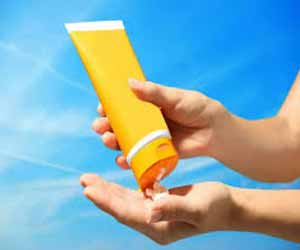- Home
- Editorial
- News
- Practice Guidelines
- Anesthesiology Guidelines
- Cancer Guidelines
- Cardiac Sciences Guidelines
- Critical Care Guidelines
- Dentistry Guidelines
- Dermatology Guidelines
- Diabetes and Endo Guidelines
- Diagnostics Guidelines
- ENT Guidelines
- Featured Practice Guidelines
- Gastroenterology Guidelines
- Geriatrics Guidelines
- Medicine Guidelines
- Nephrology Guidelines
- Neurosciences Guidelines
- Obs and Gynae Guidelines
- Ophthalmology Guidelines
- Orthopaedics Guidelines
- Paediatrics Guidelines
- Psychiatry Guidelines
- Pulmonology Guidelines
- Radiology Guidelines
- Surgery Guidelines
- Urology Guidelines
Homemade sunscreens are new recipe for sunburn prevention

Homemade sunscreens are new recipe for sunburn prevention if one goes by the Social media interactions. The latest Recent trend depicts consumer interest in natural, organic, and ethically-made personal care products which has led to an increase of shared recipes for homemade products including sunscreen.
A new study conducted by researchers at the Center for Injury Research and Policy at Nationwide Children's Hospital and the Brooks College of Health at University of North Florida examined how homemade sunscreens were portrayed on Pinterest.
The study, published today in Health Communication, found that nearly all (95%) pins, or bookmarks, for homemade sunscreen positively portrayed the effectiveness of homemade sunscreens and most (68%) recommended recipes for homemade sunscreens that offered insufficient UV radiation protection. Sun Protection Factor (SPF) claims were made in a third of pins with a range of SPF 2 to SPF 50. This is concerning because the ingredients recommended in homemade sunscreen pins offer minimal scientifically proven broad-spectrum protection from UV radiation yet are widely shared and promoted as safe alternatives to commercial sunscreens on Pinterest. The average number of saves for a pin was 808, with one pin being saved more than 21,700 times.
"The internet is a great place for families to go to for recipe inspiration and arts and crafts projects, but not necessarily for making their own safety-related things," said Lara McKenzie, PhD, co-author of this study and principal investigator in the Center for Injury Research and Policy at Nationwide Children's. "Homemade sunscreen products are risky because they are not regulated or tested for efficacy like commercial sunscreens. When you make it yourself, you don't know if it's safe or effective." With rising skin cancer rates, the use of effective broadband sunscreen is critical to protect the skin from UV radiation and reduce incidence of skin cancer.
Just because you make it yourself or something is labeled as natural or has fewer ingredients doesn't necessarily mean it's safer. The best sunscreen is one that can be regularly applied and stay on the skin without causing irritation or other side effects, which usually depend on the child and the activity. It often takes a trial of several sunscreens before finding the one that does the job best for your family, even if that means everyone uses a different type of product. Here are some tips on how to protect your child's skin:
- Use an FDA-approved sunscreen. The American Academy of Dermatology recommends that everyone 6 months and older wear sunscreen. Make sure the sunscreen has these characteristics:
- Broad spectrum, which protects against UVA and UVB sunrays.
- Water-resistant (effective for up to 40 minutes in water) or very water resistant (effective for up to 80 minutes in water).
- Sun Protection Factor (SPF) of 30 or higher.
- Start early. Children whose parents regularly apply sunscreen at an early age are more likely to continue using sunscreen as teenagers and adults. Make a habit of using sunscreen to set kids up for a lifetime of safely enjoying outdoor activities.
- Apply early and often. Sunscreen should be applied in a thick layer (about ¼ teaspoon for a toddler's face), 30 minutes before heading outside and reapplied every 2 hours. If children are swimming or sweating a lot, reapply sunscreen more often and use a water-resistant formula. For a week-long beach vacation, a school-aged child should go through an entire 8 oz. bottle of sunscreen, applying it twice a day.
- Throw out expired or old sunscreen. Look for an expiration date on the bottle and throw out expired sunscreen. If there is no expiration date, throw out sunscreen three years after opening. If your sunscreen looks or feels really different - it's much thicker or thinner or the color has changed - throw it out.

Disclaimer: This site is primarily intended for healthcare professionals. Any content/information on this website does not replace the advice of medical and/or health professionals and should not be construed as medical/diagnostic advice/endorsement or prescription. Use of this site is subject to our terms of use, privacy policy, advertisement policy. © 2020 Minerva Medical Treatment Pvt Ltd